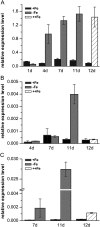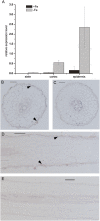AhNRAMP1 iron transporter is involved in iron acquisition in peanut
- PMID: 22611231
- PMCID: PMC3421984
- DOI: 10.1093/jxb/ers117
AhNRAMP1 iron transporter is involved in iron acquisition in peanut
Abstract
Peanut/maize intercropping is a sustainable and effective agroecosystem to alleviate iron-deficiency chlorosis. Using suppression subtractive hybridization from the roots of intercropped and monocropped peanut which show different iron nutrition levels, a peanut gene, AhNRAMP1, which belongs to divalent metal transporters of the natural resistance-associated macrophage protein (NRAMP) gene family was isolated. Yeast complementation assays suggested that AhNRAMP1 encodes a functional iron transporter. Moreover, the mRNA level of AhNRAMP1 was obviously induced by iron deficiency in both roots and leaves. Transient expression, laser microdissection, and in situ hybridization analyses revealed that AhNRAMP1 was mainly localized on the plasma membrane of the epidermis of peanut roots. Induced expression of AhNRAMP1 in tobacco conferred enhanced tolerance to iron deprivation. These results suggest that the AhNRAMP1 is possibly involved in iron acquisition in peanut plants.
Figures






Similar articles
-
Comparative transcriptomic analysis of the roots of intercropped peanut and maize reveals novel insights into peanut iron nutrition.Plant Physiol Biochem. 2018 Jun;127:516-524. doi: 10.1016/j.plaphy.2018.04.024. Epub 2018 Apr 23. Plant Physiol Biochem. 2018. PMID: 29715682
-
Regulation of AhFRO1, an Fe(III)-chelate reductase of peanut, during iron deficiency stress and intercropping with maize.Physiol Plant. 2009 Jul;136(3):274-83. doi: 10.1111/j.1399-3054.2009.01219.x. Epub 2009 Feb 12. Physiol Plant. 2009. PMID: 19453500
-
Molecular evidence for phytosiderophore-induced improvement of iron nutrition of peanut intercropped with maize in calcareous soil.Plant Cell Environ. 2013 Oct;36(10):1888-902. doi: 10.1111/pce.12097. Epub 2013 Apr 25. Plant Cell Environ. 2013. PMID: 23496756
-
Cloning and functional analysis of the peanut iron transporter AhIRT1 during iron deficiency stress and intercropping with maize.J Plant Physiol. 2010 Aug 15;167(12):996-1002. doi: 10.1016/j.jplph.2009.12.019. Epub 2010 Apr 28. J Plant Physiol. 2010. PMID: 20430476
-
Critical Issues in the Study of Magnesium Transport Systems and Magnesium Deficiency Symptoms in Plants.Int J Mol Sci. 2015 Sep 23;16(9):23076-93. doi: 10.3390/ijms160923076. Int J Mol Sci. 2015. PMID: 26404266 Free PMC article. Review.
Cited by
-
Genome-Wide Identification and Expression Analysis Reveals Roles of the NRAMP Gene Family in Iron/Cadmium Interactions in Peanut.Int J Mol Sci. 2023 Jan 15;24(2):1713. doi: 10.3390/ijms24021713. Int J Mol Sci. 2023. PMID: 36675227 Free PMC article.
-
Molecular Mechanisms and Biochemical Pathways for Micronutrient Acquisition and Storage in Legumes to Support Biofortification for Nutritional Security.Front Plant Sci. 2021 Jun 7;12:682842. doi: 10.3389/fpls.2021.682842. eCollection 2021. Front Plant Sci. 2021. PMID: 34163513 Free PMC article. Review.
-
Genome-Wide Identification and Expression Profile Reveal Potential Roles of Peanut ZIP Family Genes in Zinc/Iron-Deficiency Tolerance.Plants (Basel). 2022 Mar 16;11(6):786. doi: 10.3390/plants11060786. Plants (Basel). 2022. PMID: 35336668 Free PMC article.
-
MsNRAMP2 Enhances Tolerance to Iron Excess Stress in Nicotiana tabacum and MsMYB Binds to Its Promoter.Int J Mol Sci. 2023 Jul 10;24(14):11278. doi: 10.3390/ijms241411278. Int J Mol Sci. 2023. PMID: 37511038 Free PMC article.
-
Genome-Wide Identification and Expression Analysis of NRAMP Family Genes in Soybean (Glycine Max L.).Front Plant Sci. 2017 Aug 18;8:1436. doi: 10.3389/fpls.2017.01436. eCollection 2017. Front Plant Sci. 2017. PMID: 28868061 Free PMC article.
References
-
- Belouchi A, Kwan T, Gros P. Cloning and characterization of the OsNramp family from Oryza sativa, a new family of membrane proteins possibly implicated in the transport of metal ions. Plant Molecular Biology. 1997;33:1085–1092. - PubMed
-
- Bereczky Z, Wang HY, Schubert V, Ganal M, Bauer P. Differential regulation of nramp and irt metal transporter genes in wild type and iron uptake mutants of tomato. Journal of Biological Chemistry. 2003;278:24697–24704. - PubMed
-
- Cailliatte R, Lapeyre B, Briat JF, Mari S, Curie C. The NRAMP6 metal transporter contributes to cadmium toxicity. Biochemical Journal. 2009;422:217–228. - PubMed
Publication types
MeSH terms
Substances
Associated data
- Actions
LinkOut - more resources
Full Text Sources
Medical
Molecular Biology Databases

